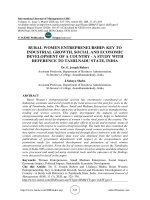Economic growth and economic development 96
Bạn đang xem bản rút gọn của tài liệu. Xem và tải ngay bản đầy đủ của tài liệu tại đây (115.27 KB, 1 trang )
Introduction to Modern Economic Growth
2.6.2. Types of Neutral Technological Progress. What are some convenient special forms of the general production function F [K (t) , L (t) , A (t)]? First
we could have
F [K (t) , L (t) , A (t)] = A (t) F˜ [K (t) , L (t)] ,
for some constant returns to scale function F˜ . This functional form implies that
the technology term A (t) is simply a multiplicative constant in front of another
(quasi-) production function F˜ and is referred to as Hicks-neutral after the famous
British economist John Hicks. Intuitively, consider the isoquants of the function
F [K (t) , L (t) , A (t)] in the L-K space, which plot combinations of labor and capital
for a given technology A (t) such that the level of production is constant. This
is shown in Figure 2.12. Hicks-neutral technological progress, in the first panel,
corresponds to a relabeling of the isoquants (without any change in their shape).
Another alternative is to have capital-augmenting or Solow-neutral technological
progress, in the form
F [K (t) , L (t) , A (t)] = F˜ [A (t) K (t) , L (t)] .
This is also referred to as capital-augmenting progress, because a higher A (t) is
equivalent to the economy having more capital. This type of technological progress
corresponds to the isoquants shifting with technological progress in a way that they
have constant slope at a given labor-output ratio and is shown in the second panel
of Figure 2.12.
Finally, we can have labor-augmenting or Harrod-neutral technological progress,
named after an early influential growth theorist Roy Harrod, who we encountered
above in the context of the Harrod-Domar model previously:
F [K (t) , L (t) , A (t)] = F˜ [K (t) , A (t) L (t)] .
This functional form implies that an increase in technology A (t) increases output
as if the economy had more labor. Equivalently, the slope of the isoquants are
constant along rays with constant capital-output ratio, and the approximate shape
of the isoquants are plotted in the third panel of Figure 2.12.
Of course, in practice technological change can be a mixture of these, so we
could have a vector valued index of technology A (t) = (AH (t) , AK (t) , AL (t)) and
82









